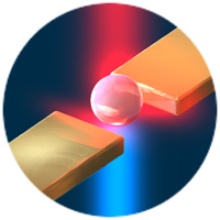In the field of research "Nonlinear Plasmonics" two of the main research topics of the 4th Physics Institute are merged and brought together, which are the "Development of high-power widely tunable ultrafast laser sources" and the "Research in optical properties of metal nanostructures and plasmonics metamaterials".
We study the optical response of metal nanoparticles under the illumination of high-power ultrashort laser pulses. The term "ultrashort" means, that the pulse duration of the laser pulses is on the order of femtoseconds (10-15s) and these generate when focused onto the nanostructures light intensities in the ~10 GW/cm² range. When such an intense light beam interacts with matter the enormous light intensities lead to a plethora of new phenomena, which we usually do not observe in every day experience, since e. g. sunlight propagating through a glass window simply does not deliver the necessary electric fields strength. In particular, the new nonlinear optical effects lead often to the generation of new frequency components (colors) of the propagating laser beam. The most famous phenomena are probably "Second Harmonic Generation" (SHG) or "Third Harmonic Generation" (THG). In SHG for example two incoming photons are combined via the light-matter interaction into one outcoming photon of twice the energy of the incoming photon. This effect is very often used for green laser pointers, where actually an infrared laser at a wavelength of 1064nm is frequency doubled in a nonlinear optical crystal to a wavelength of 532nm, which corresponds to green color.
While these effects in principle can be observed in nearly any kind of matter, metal nanoparticles allow to further boost the conversion efficiency of nonlinear optical effects on the nanoscale. Similar to radio wave metal antennas, where incoming electromagnetic waves excite oscillations of the conduction electrons in the antennas, visible or infrared light can generate oscillations of the conduction electrons in metal nanoparticles. When resonantly excited the nanoparticles as well serve as antennas and allow to catch the incoming radiation and concentrate the light to regions, which are even much smaller than the wavelength of the incoming light. In these regions, which are also called hot-spots of the antennas, the electric field strength can be a multiple of the incoming field strength. Therefore, nonlinear optical processes like SHG or THG can be tremendously enhanced in the hot-spot of the metal nanoparticles. In this project we investigate the influence of the metal nanoantenna geometry on different nonlinear optical effects and try to boost the conversion efficiency even further by combining metal nanoantennas with other highly nonlinear optical materials.
Further Information
- Doubling the efficiency of third harmonic generation by positioning ITO nanocrystals into the hot-spot of plasmonic gap-antennas
B. Metzger, M. Hentschel, T. Schumacher, M. Lippitz, X. Ye, C. Murray, B. Knabe, K. Buse and H. Giessen
Nano Lett. 14, 2867 (2014). - Quantitative Modelling of the Third Harmonic Emission Spectrum of Plasmonic Nanoantennas
M. Hentschel, T. Utikal, H. Giessen and M. Lippitz
Nano Lett. 12, 3778 (2012). - Third harmonic spectroscopy and modeling of the nonlinear response of plasmonic nanoantennas
B. Metzger, M. Hentschel, M. Lippitz and H. Giessen
Opt. Lett. 37, 4741 (2012).




